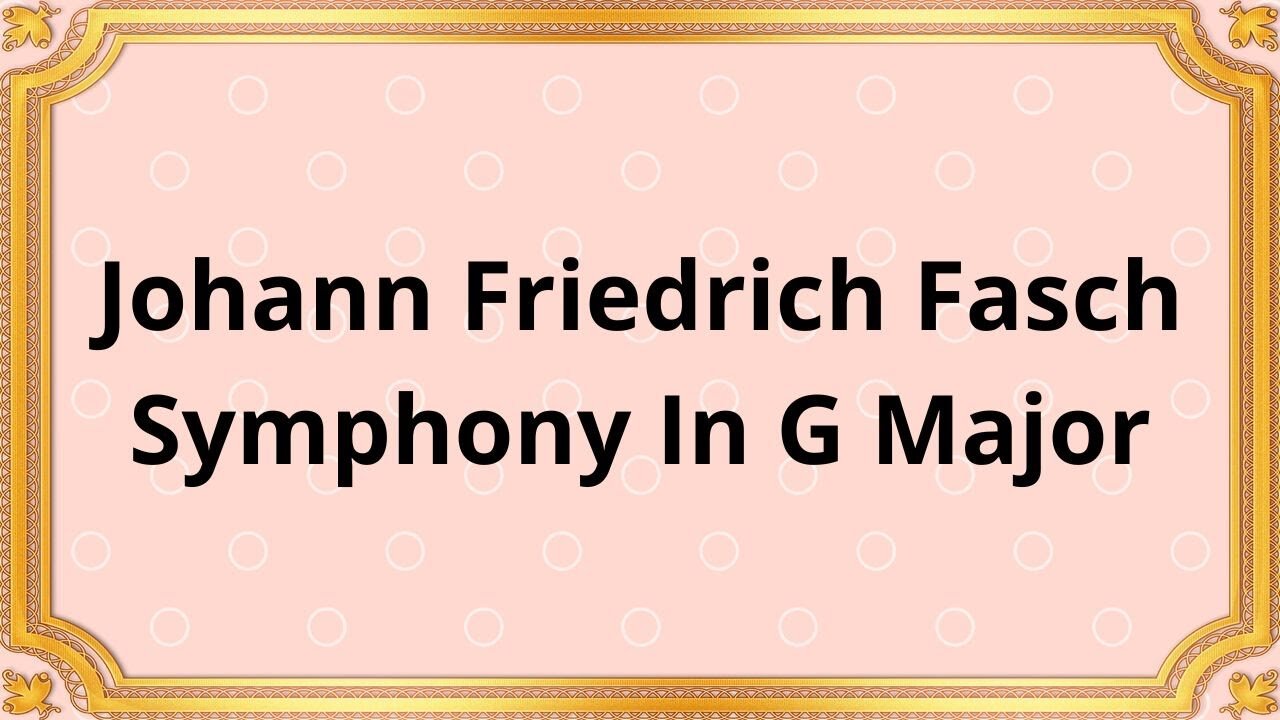Premium Only Content

Johann Friedrich Fasch Symphony In G Major
#JohannFriedrichFasch #SymphonyInGmajor #ClassicalMusic #MusicalComposition #BaroqueEra #BaroqueMusic
MANNHEIMER SOLOISTS WOLFGANG HOFMANN,. CONDUCTOR
Johann Friedrich Fasch, a prominent German composer of the Baroque era, is known for his contributions to the world of classical music. One of his remarkable compositions, the Symphony in G Major, showcases his exceptional talent and embodies the essence of the Baroque period.
Johann Friedrich Fasch, active during the late 17th and early 18th centuries, was a highly regarded composer who played a significant role in the development of the Baroque style. The Symphony in G Major, composed during the Baroque era, reflects the musical trends and stylistic characteristics of the time. Fasch's compositions were lauded for their technical brilliance, expressive qualities, and innovative approaches to orchestration.
Fasch's Symphony in G Major is an instrumental work that exemplifies the attributes of the Baroque symphony. This composition is typically structured in multiple movements, each with its own distinct character and musical ideas. The symphony is scored for a diverse ensemble, often including strings, woodwinds, and brass instruments.
The opening movement, marked Allegro, introduces the listener to a lively and spirited melody. Fasch's orchestration shines through as he weaves together the various instrumental voices, creating a rich tapestry of sound. The contrasting middle movement, often an Adagio or Largo, provides a moment of introspection and emotional depth. It showcases Fasch's ability to evoke a range of emotions through his use of harmonies, dynamics, and melodic contours. The final movement, typically a fast-paced Allegro, showcases Fasch's command of counterpoint and his ability to create energetic and exhilarating musical passages that captivate the listener.
Johann Friedrich Fasch's Symphony in G Major holds immense significance within the realm of Baroque music. Its technical demands, harmonic richness, and expressive qualities highlight Fasch's compositional prowess. This composition serves as a testament to his ability to blend melodic beauty, intricate counterpoint, and innovative orchestration techniques.
The Symphony in G Major's lasting legacy lies in its influence on subsequent composers and its enduring popularity among performers and audiences alike. Fasch's skillful blending of form and expression, as well as his ability to create compelling musical narratives, paved the way for future developments in symphonic composition. This work serves as a bridge between the Baroque and Classical periods, showcasing Fasch's innovative approaches while still adhering to the stylistic conventions of the time.
Conclusion:
Johann Friedrich Fasch's Symphony in G Major stands as a testament to his remarkable talent and the richness of Baroque music. Its lively melodies, intricate counterpoint, and innovative orchestration captivate listeners and provide a glimpse into the musical world of the time. Fasch's ability to infuse emotion and technical brilliance into his compositions solidifies his place as a distinguished figure in the history of classical music. As we explore the depths of the Symphony in G Major, we are reminded of the enduring legacy of Johann Friedrich Fasch and his significant contributions to the world of music.
You have the opportunity to support the channel:
https://destream.net/live/RadSiarAl/donate
https://www.buymeacoffee.com/6355radsiaral
-
 32:30
32:30
Classical music_Music Inspiration
9 days agoArturo Toscanini Grand Canyon Suite
491 -
 3:16:25
3:16:25
Barry Cunningham
7 hours agoPRESIDENT TRUMP: NOTHING CAN STOP WHAT IS COMING! ARE YOU READY?
70.7K42 -
 13:06
13:06
Colion Noir
7 hours agoOpen Carrier Killed With His Own Gun At Autozone | Open Carry Gone Wrong
54.3K36 -
 57:09
57:09
Kitco NEWS
11 hours agoFiat Collapse Ahead Gold to $8,900 in Global Monetary Shift
16.5K4 -
 16:46
16:46
Nick Shirley
13 hours ago $1.82 earnedAsking Democrats About the Joe Biden Cover Up Scam
22.4K12 -
 2:24:06
2:24:06
I_Came_With_Fire_Podcast
4 hours agoThe 2017 Las Vegas Shooting: Conspiracy, Critical Thinking, and Narratives
18.2K3 -
 9:44
9:44
Melonie Mac
11 hours agoTwitch is Cooked
20.1K15 -
 1:10:41
1:10:41
Glenn Greenwald
11 hours agoSYSTEM UPDATE REVISITED: Prof. John Mearsheimer on Ukraine; Plus: Fallout from a Changing Syria
125K25 -
 1:30:20
1:30:20
Precision Rifle Network
1 day agoS4E17 Guns & Grub - Industry News, 2A, More Training Tips
16.3K3 -
 2:06:13
2:06:13
megimu32
5 hours agoON THE SUBJECT: Icons, Chaos & First-Play Flashbacks - Music Video Nostalgia & Wild Headlines
18.1K8